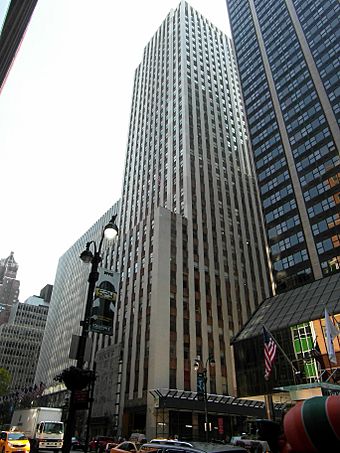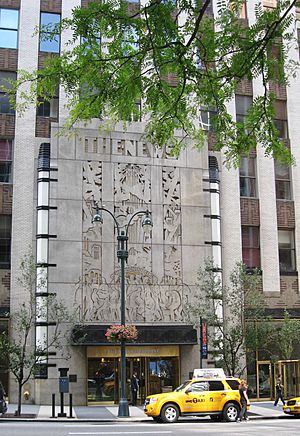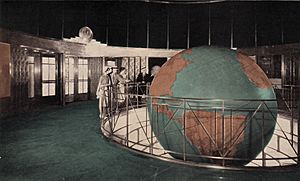Daily News Building facts for kids
|
Daily News Building
|
|

Viewed from 42nd Street, looking southeast
|
|
| Location | 220 East 42nd Street, Manhattan, New York |
|---|---|
| Built | 1929–1930 |
| Architect | Raymond Hood and John Mead Howells |
| Architectural style | Art Deco, Modernist |
| NRHP reference No. | 82001191 |
Quick facts for kids Significant dates |
|
| Added to NRHP | November 14, 1982 |
| Designated NHL | June 29, 1989 |
The Daily News Building, also known as The News Building, is a tall skyscraper located at 220 East 42nd Street in the Turtle Bay area of Midtown Manhattan, New York City. The first part of the building was designed by architects Raymond Hood and John Mead Howells. They built it in the Art Deco style between 1928 and 1930. Later, another part was added by Harrison & Abramovitz from 1957 to 1960.
The Daily News Building has a 36-story tower that is about 476 feet (145 m) tall. It also has two shorter sections that stretch towards Second Avenue. The building is known for its large granite entrance on 42nd Street and a huge, impressive lobby inside. The original building was shaped like an "L". It faced 41st Street, Second Avenue, and 42nd Street. The newer part made the building a more rectangular shape.
This building was ordered by Joseph Medill Patterson, who started the New York Daily News newspaper. The design uses a layered look with parts of the building stepping back as it goes higher. It was one of the first big Art Deco buildings in New York City. The Daily News newspaper used this building until 1995. After that, it was changed into office spaces. The Daily News Building was named a National Historic Landmark in 1978. It also became a New York City Landmark in 1981, and its lobby was given the same honor in 1998.
Contents
About the Daily News Building's Location
The Daily News Building is at 220 East 42nd Street in East Midtown. It's on the south side of the street, between Third Avenue and Second Avenue. The building is bordered by 42nd Street to the north and 41st Street to the south. To the east is Second Avenue, and to the west is a private alley called Kempner Place.
Many famous places are nearby. The New York City Subway's Grand Central–42nd Street station is one block west. Also close by are the Chrysler Building and the Socony–Mobil Building. A block to the east, you can find Tudor City and the Ford Foundation Building.
How the Daily News Building Was Designed
The Daily News Building was designed in the Art Deco style by Raymond Hood and John Mead Howells. It was built to be the main office for the New York Daily News newspaper. This building was one of the first skyscrapers that didn't have a fancy, decorated top. This was different from Hood's earlier designs, like the Tribune Tower in Chicago. Later, Harrison & Abramovitz designed additions to the building, which were built between 1957 and 1960.
Raymond Hood designed the building to be very practical. He believed that the simplest way to make the outside look good was to use colors. The upper floors were planned as open spaces that could be easily divided into offices.
What the Building Looks Like
The shape of the building was influenced by city rules from 1916. The main 36-story tower is on the north side, facing 42nd Street. It has an "L" shape. It stretches about 91 feet (28 m) along 42nd Street and about 300 feet (91 m) along 41st Street. The original tower has several "setbacks," which means parts of the building step back as it gets higher. For example, on the 42nd Street side, there's a big setback at the 9th floor.
The southern part of the Daily News Building, near 41st Street, is shorter than the tower. This section used to be the printing plant for the newspaper. It was first nine stories tall. In the late 1950s, five more stories were added, set back from the original part. An 18-story annex was also built in the late 1950s, facing Second Avenue and 42nd Street.
The Outside Look (Facade)
The outside walls of the tower have vertical sections of windows. These are separated by white brick walls that are placed in an interesting, uneven way. You can also see patterns made from different colored bricks and red curtains. The panels between the windows on each floor are made of reddish-brown and black brick. These panels have cool geometric patterns on the lower floors. On the upper floors, they are simpler, just horizontal bars.
At the bottom of the tower, on the 42nd Street side, there's a three-story-tall main entrance made of granite. Above the entrance, you can see the words "the-news" carved into the stone. Below that is a large carving (called a bas-relief) showing people and the words "he made so many of them". This quote is from Abraham Lincoln and refers to the "common people" that the Daily News newspaper was for. There are glass columns on each side of the entrance, topped with bronze decorations.
The original printing plant on 41st Street has a similar look to the tower. The annex, added later, also has vertical stripes, but they are wider. Both the original building and the annex use light and dark red bricks between the windows.
The Lobby
The lobby of the Daily News Building is very famous. It has a round room (a rotunda) with a black glass dome ceiling near the 42nd Street entrance. Under this dome, in a sunken area, is the world's largest indoor globe! The Daily News wanted it to be a permanent science exhibit for learning. The globe is about 12 feet (3.7 m) wide and shows over 3,000 different places.
On the floor, there's a large compass. Bronze designs are etched into the floor, showing the names of major cities and how far they are from New York City. The walls have nineteen panels designed by J. Henry Weber. These panels show maps, weather charts, and clocks from different time zones around the world. The main elevator areas are south of the rotunda. They have bronze plaques that remember Daily News employees who fought in major wars.
The idea for the rotunda was inspired by other famous buildings. Some say the newspaper's founder, Joseph Medill Patterson, first suggested the globe. Others say the architect, Hood, came up with the idea. The lobby was so popular that Hood had to open a special side entrance just for the newspaper's employees!
History of the Daily News Building
The Medill family owned many large newspapers in the early 1900s. Joseph Medill Patterson started the Daily News in 1919. It was the first daily tabloid newspaper in the United States. At first, it wasn't very popular, but by 1925, it became New York City's biggest newspaper. It sold over a million copies every day!
The Daily News first had offices in Lower Manhattan. But by 1927, their building was too small. They decided to look for a new location, following other newspapers that had moved to Midtown Manhattan. Patterson thought the 42nd Street location was perfect because it was near Times Square, where their rival newspaper, The New York Times, was located.
How It Was Planned and Built
Planning the Building
The Daily News bought a large piece of land on East 42nd Street in February 1928. It cost $2.5 million. At first, they planned a 20-story building. Patterson chose Hood and Howells as the architects. They had already won a contest to design the Tribune Tower in Chicago, which was owned by Patterson's cousin.
Hood first suggested a tall tower for the Daily News Building. Patterson didn't want it to be a "monument," but Hood convinced him it would be the most "efficient" business choice. Hood showed Patterson many models until he agreed to a skyscraper of 35 to 40 stories. They decided to use brick instead of more expensive limestone to save money.
Building the Daily News Building
The building plans were filed in June 1928. At that time, it was going to be 36 stories and cost $6.6 million. The steel frame was finished by August 1929.
By late 1929, the Daily News Building was almost done. Other tall buildings were also being built on East 42nd Street, changing the area a lot. The Daily News started moving into the building in mid-1930. The lobby opened to the public on July 23, 1930. The whole building, including the new printing presses, cost $10.7 million.
Early Years and Expansion
The Daily News newspaper found the building very helpful for their work. The lobby, with its famous globe, was very popular. About 625,000 people visited it each year by 1938. The Daily News rented out the extra office space to other companies. For example, United Press International moved its main office there in 1931. The Daily News' own TV station, WPIX, also had offices and broadcast from the building's tall mast until 1951.
In the late 1950s, the Daily News decided to expand the building. They hired Harrison & Abramovitz to design new parts and update the old ones. The project cost $20 million. The building almost doubled in size. Work started in May 1957, and the new parts were finished by June 1960. The globe in the lobby was also cleaned and fixed between 1966 and 1967.
Later Years of the Building
By the 1970s, the Daily News and the International Paper Company were the main tenants. When International Paper moved out in 1978, the empty space was quickly filled. In 1982, Tribune Media, which owned the Daily News, sold the Daily News Building to a group of investors. As part of this sale, the newspaper's printing and delivery operations moved to other locations. In 1984, the Daily News removed its printing presses from the building. This freed up a lot of space that was turned into offices.
The Daily News newspaper moved out completely in May 1995. The next year, a developer named Steve Witkoff bought the building. He rented out most of the empty space. In 1997, the Omnicom Group signed a lease for most of the building, becoming its main tenant. SL Green Realty bought the Daily News Building in 2003 for $265 million. In 2020, SL Green got a new $510 million loan for the building. Even with financial challenges, the Daily News Building was almost completely rented out by then.
Who Works There Now
The building is still home to WPIX, channel 11, which used to be the Daily News' TV station. It's now part of The CW network. Another radio station, WQCD, which played smooth jazz, also used to be there.
Today, the Visiting Nurse Service of New York uses a large part of the building. The nonprofit Young Adult Institute also has offices there. Other groups that rent space include the United Nations Development Programme and UN Women. The New York office of the public relations company FleishmanHillard is also a tenant.
How the Building Made an Impact
The Daily News' own historians wrote in 1971 that "the building did a lot for the paper." They praised the building, especially its lobby. The Daily News newspaper itself once wrote that the building's design was focused on "efficient production of newspapers." When it first opened, the Daily News said the lobby had a very modern exhibit.
Special Landmark Status
The outside of the Daily News Building was named a New York City Landmark in 1981. Its first-floor lobby was also given this special status in 1998. The New York City Landmarks Preservation Commission called it "one of the city's major Art Deco presences." It also became a National Historic Landmark in 1989. Only the original tower and printing plant are part of these landmark designations.
In Movies and Media
A drawing of the Daily News Building from 1930 inspired the design of the fictional Daily Planet headquarters in the Superman stories. The Daily News Building was even used for filming the outside scenes of the Daily Planet in the 1978 movie Superman: The Movie. During the New York City blackout of 1977 in July 1977, the film crews even lent their bright lights to the Daily News editors so they could print the next day's newspaper!
Images for kids
See also
 In Spanish: Daily News Building para niños
In Spanish: Daily News Building para niños





